by Katie Sperry, graduate student at Northeastern University and the Plum Island Ecosystems LTER
By culturing fungi living within salt marsh plants, Postdoctoral Researcher Dr. Kylea Garces and PhD student Mya Darsan can learn not only what fungi are present, but how they benefit their plant hosts.
Fun, fuzzy, fungus
“This is the first one I’ve been repulsed by,” says Dr. Kylea Garces, lifting a petri dish of brown, slimy fungus up to the light to see it better. Far more commonly, she exclaims about the “beautiful” or “cute” organisms growing in the many petri dishes stacked up like poker chips around her and PhD student Mya Darsan. “Oooh, this is a fun, peachy one,” Mya says to me, handing over a small dish for closer inspection. Indeed, a very fun, very fuzzy, peach-colored, tendrilled fungus is growing in the clear agar of the dish. “This one looks like black pepper,” Kylea says, pointing to a dish dotted throughout by small black fungus flecks. I’m quickly learning that descriptive language is key to fungal research.
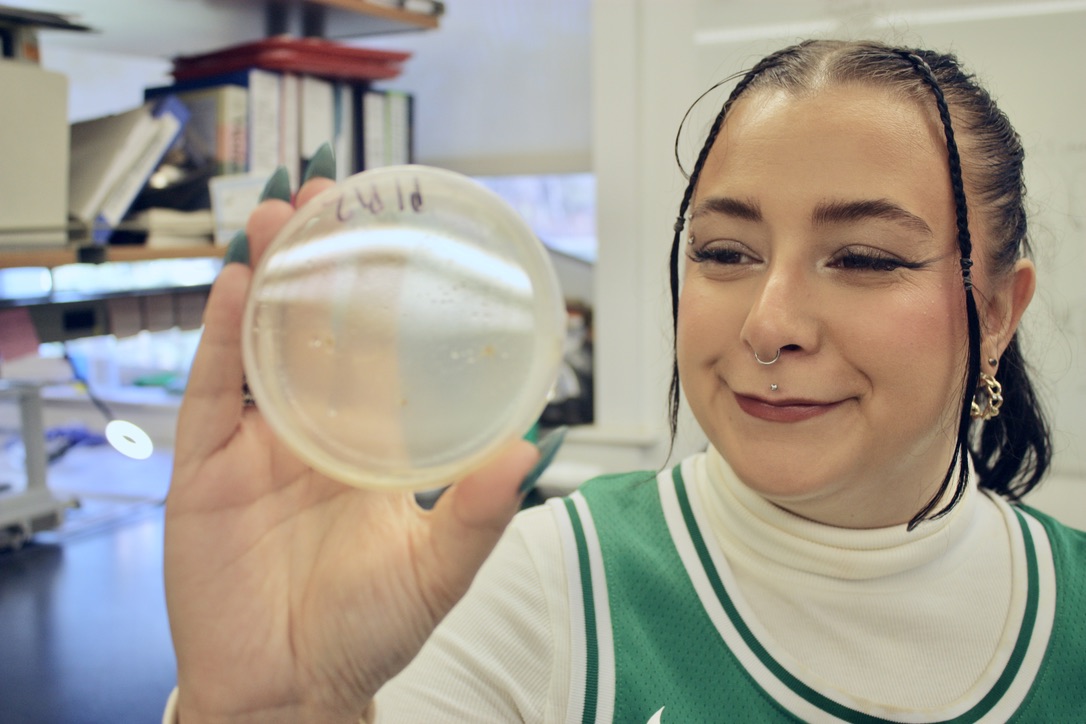
Credit: Katie Sperry, CC BY-SA 4.0.
Kylea, Mya, and I have been working in the same lab for the last few months, so I’ve heard these descriptions for a while. However, I only occasionally absorbed their words when they permeated through my headphones. Today, though, I’m in their fungal world, watching as they morphotype their fungi (i.e., grouping them by growth characteristics). Their many cultures were harvested, isolated, and grown from the roots of the salt marsh grass Spartina alterniflora, which they collected from a nutrient addition experiment at the Plum Island Ecosystems (PIE) LTER.
Fungi are under-studied in coastal systems. It’s this gap that Mya is drawn to for her work, she explains as she tells me how she came to fungi. “Over the summer I went to a conference and attended a fungi session for fun,” she tells me, adding that her background is in non-fungal microbial ecology. “I had already decided to come to a lab that works in salt marshes for my PhD, and all of the talks in that session were about the open ocean. No one talked about fungi in coastal systems, and it made me curious about what’s happening with fungi in the salt marsh.”
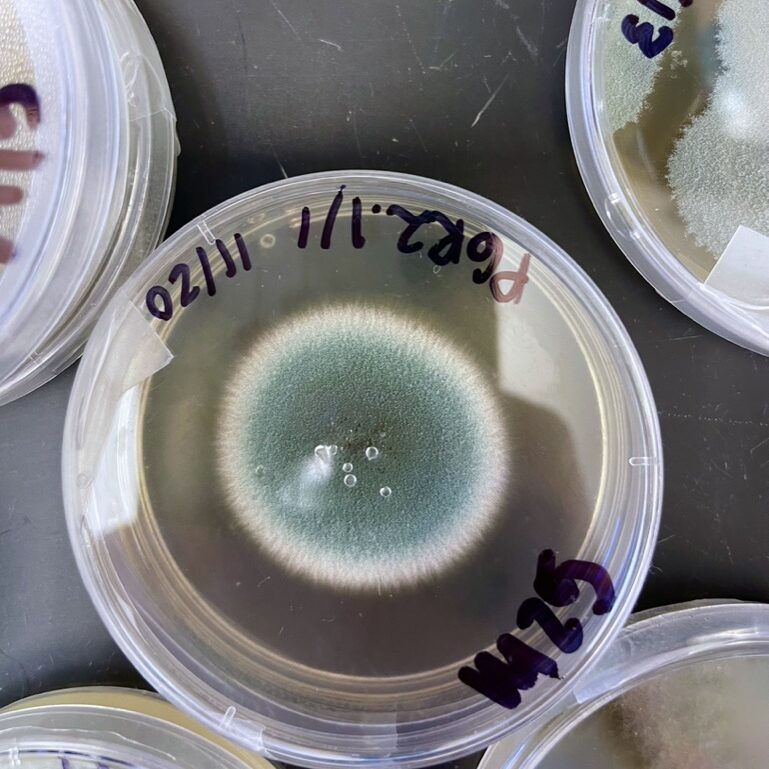
Credit: Katie Sperry, CC BY-SA 4.0.
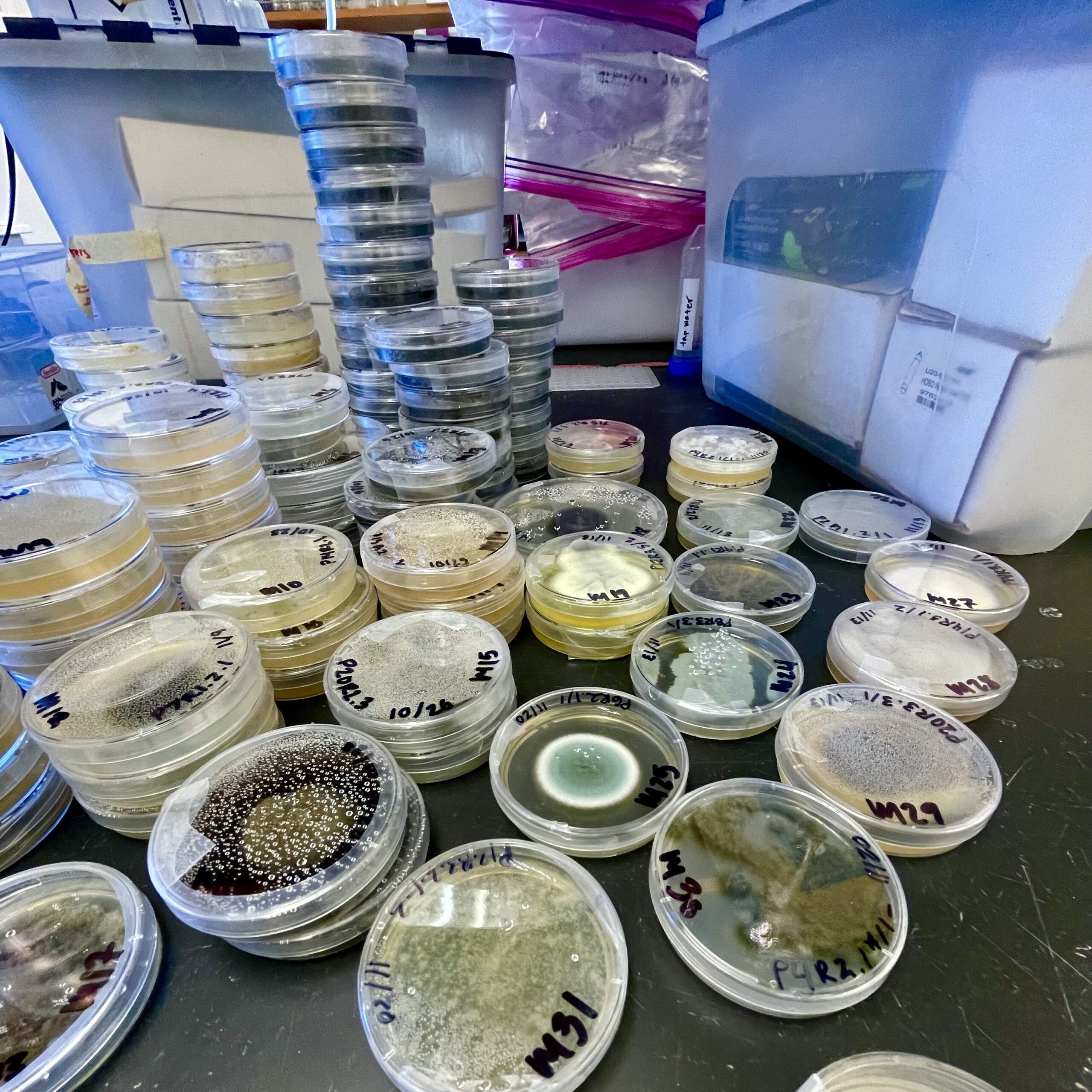
Credit: Katie Sperry, CC BY-SA 4.0.
The benefits of culturing
To understand these coastal fungi, Kylea and Mya first placed Spartina root tissue on growth medium and watched as multiple fungi made themselves known, expanding from the small bits of fungus in the root tissue to visible colonies. Then, they took these multi-taxa cultures, and successively, and very carefully, collected individuals from these fungal consortiums. Now that they have hundreds of dishes each containing a single species, they’re characterizing them to get a sense of who exactly the fungi in their collection are.
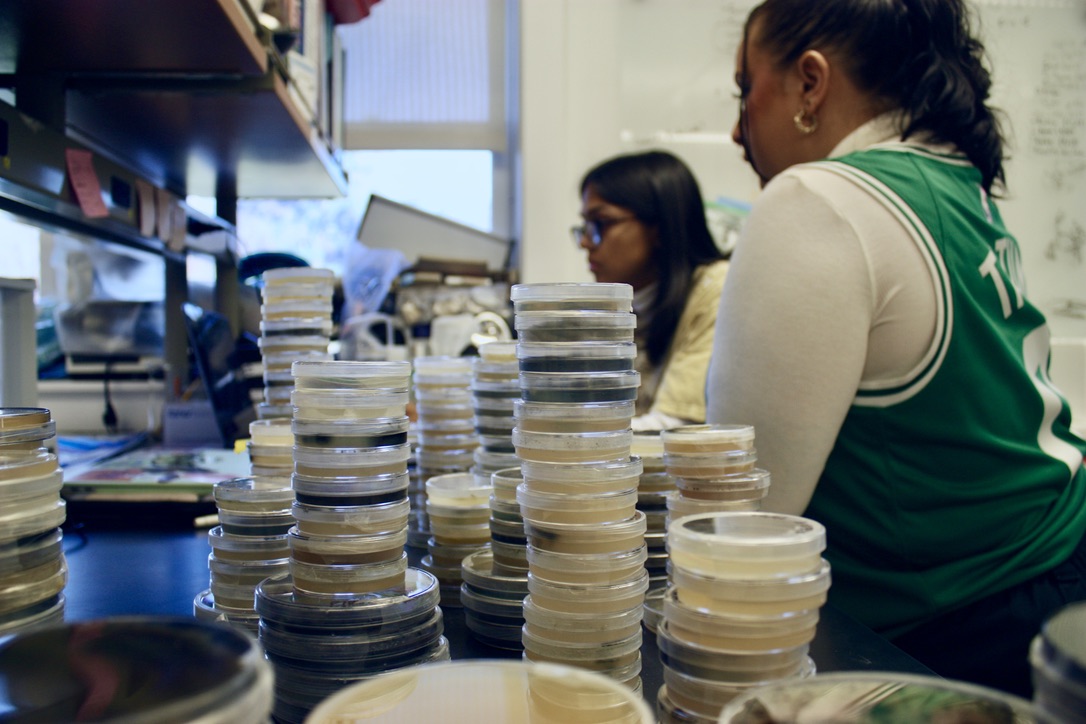
Credit: Katie Sperry, CC BY-SA 4.0.
As Kylea and Mya move around dishes, the fungal mosaic that had been the lab bench slowly turns into uniform stacks of morphotypes. Within each stack are fungus of the same color, growth habit, texture, and so on. Soon, they’ll send representatives from each morphotype out for Sanger Sequencing, to confirm that each morphotype is a single species and, as Kylea says, “to put scientific names to their fuzzy faces.”
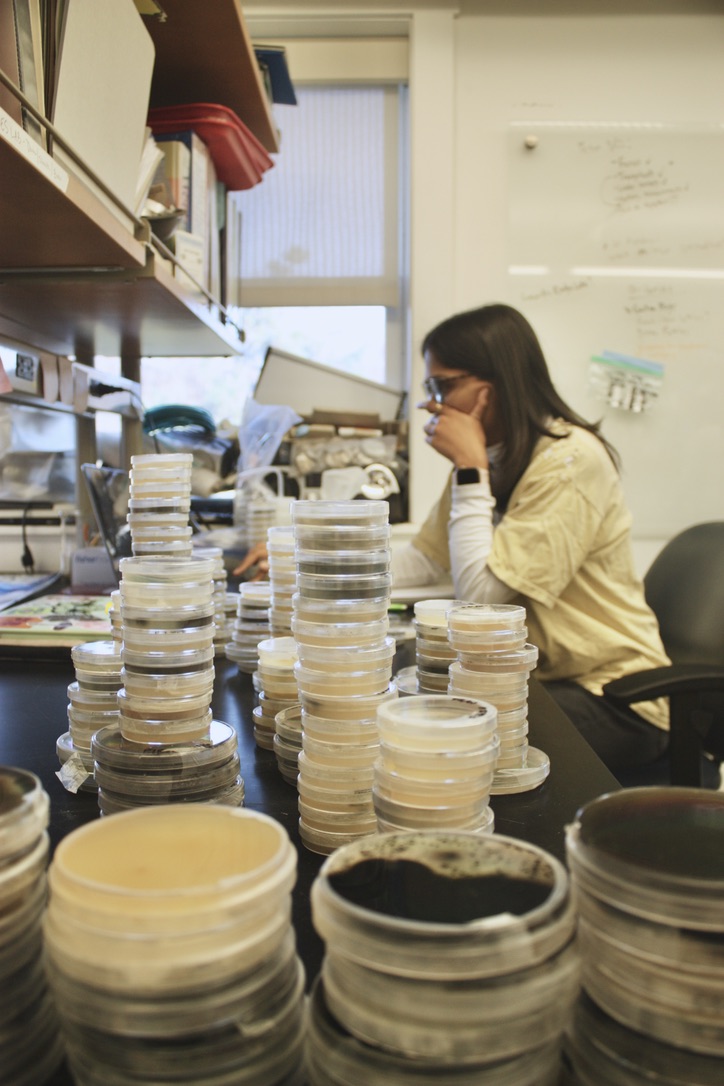
Credit: Katie Sperry, CC BY-SA 4.0.
These fuzzy faces aren’t just pretty to look at. Fungal endophytes (fungi that live within plant tissues) play all sorts of functional roles. Kylea and Mya rattle off a few as they move around their petri dishes: some can increase plant nutrient use efficiency, generate defense chemicals, or even protect a plant from solar radiation. There are many interactions that may be taking place between a fungus and its host plant, but it’s hard to know the exact role an individual fungal taxon plays.
Many fungal scientists rely on high throughput sequencing to investigate fungal communities and go straight from collected plant or dirt samples in the field to genetic data. Kylea and Mya, though, use culturing, which allows them to get at an individual fungi’s function. “With culturing, we may miss out on some species we could see with high throughput sequencing, but even if we know a fungus is there, we don’t know what it’s doing. With culturing, we can put a fungus back into a plant, and see how the plant responds,” Kylea explains.
Fungi for good
Investigating the functions of fungal endophytes isn’t just a matter of curiosity for Kylea and Mya. They’re motivated, as Kylea says, “by looking at fungi as a solution for real world problems.” The fungal endophytes they’re sorting today may have any number of functions, but it’s the fungi that form mutualist relationships with their host plants that most interest them.
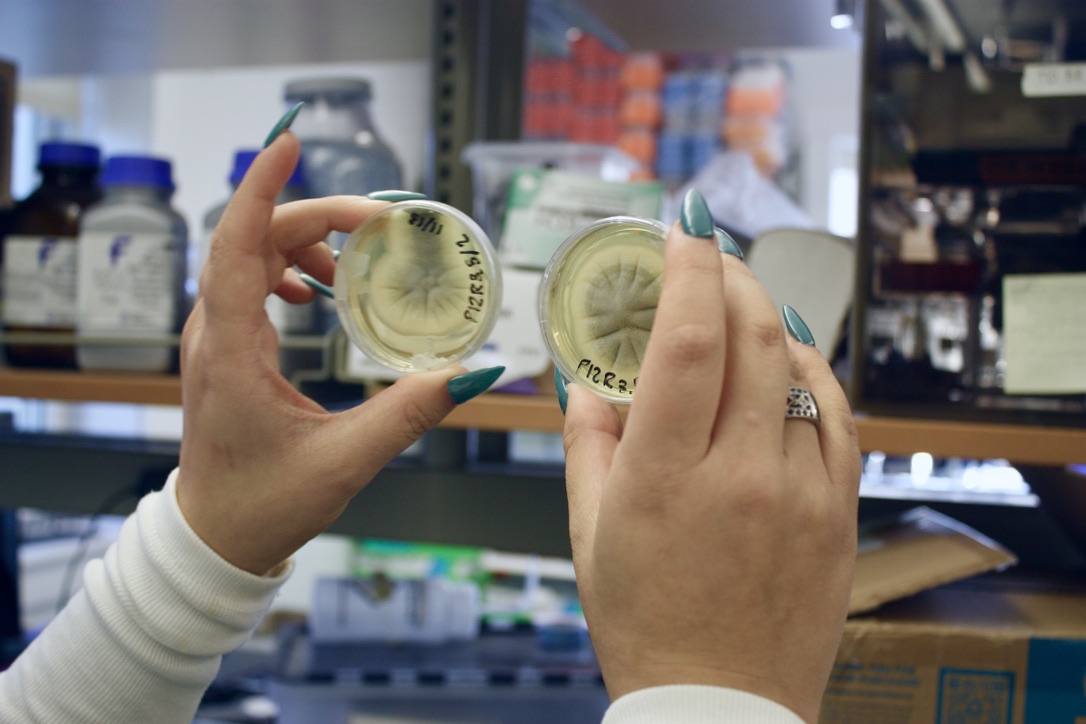
Credit: Katie Sperry, CC BY-SA 4.0.
For example, fungi might be able to mitigate the negative effects of nutrient addition on salt marsh plants, buffering them from an increasingly common human impact. Kylea and Mya harvested their fungi from a nutrient addition experiment in PIE’s salt marshes, so some of the cultured fungi could be particularly well-suited to high-nutrient environments. With their fungal cultures, they can introduce particular fungi into sterile, otherwise fungus-free, plants and measure how its presence impacts plant performance. Layering on nutrient addition treatments could identify fungal endophytes that promote plant resilience to eutrophication.
Expanding the field of fungi
Kylea and Mya’s fungal fascination sparked additional research, utilizing a pre-established nutrient addition experiment at PIE which didn’t originally have a fungal objective. “When I was looking for a postdoc, I wanted to get involved with the LTER network,” says Kylea. “Within LTERs there are so many opportunities to work with people who know different things and to work on long-running experiments. It’s a cool network to be a part of.” Kylea found potential PIE advisors Drs. Jen Bowen and Randall Hughes, and she jumped on the opportunity to bring her fungal experience to a new system.
When Kylea started her postdoc, she learned that Dr. Bowen had an incoming student with an expressed interest in fungi. This fungal fortuity allowed Mya to hit the ground running as a graduate student and has given Kylea a prime opportunity to do what she’s most invested in: mentoring.

Credit: Katie Sperry, CC BY-SA 4.0.
When Kylea talks about Mya’s growth, her voice changes from the effusive tone it has when quipping about science to something more serious. “It’s been great teaching Mya, who was interested in, but didn’t know much about, fungi. Now, she’s taking charge and knows so many things. It’s amazing to see. To me, it means more to mentor someone through the whole process than getting it done as quickly as possible. Growing and getting more diversity in the field is so important to me.”
Kylea pauses talking to me to confer with Mya on where to put a certain petri dish, demonstrating in real time her commitment to mentorship. When they settle on where to put the dish, she turns back to me and continues, “I was so happy when Jen told me there was a student interested in fungi. It’s especially amazing to mentor another woman of color. It’s a small demographic in science in general, and to mentor her in exactly the field of science I’m most passionate about is just incredible.” As Kylea speaks about mentoring in general and Mya specifically, Mya continues to move dishes around and enter data into a spreadsheet. She is unphased by the praise Kylea is throwing her way, and it strikes me that she must hear this type of thing often. Kylea continues, “I had a key mentoring experience, and I want to pay that forward and make sure Mya has a good grad school experience.” At this, Mya lifts her gaze from her fungi and says to me, “It’s like the Mandolorian. Kylea is the Mandolorian and I am baby Yoda.” Kylea laughs, “I have no idea about Star Wars, but I’m sure you’re right.”
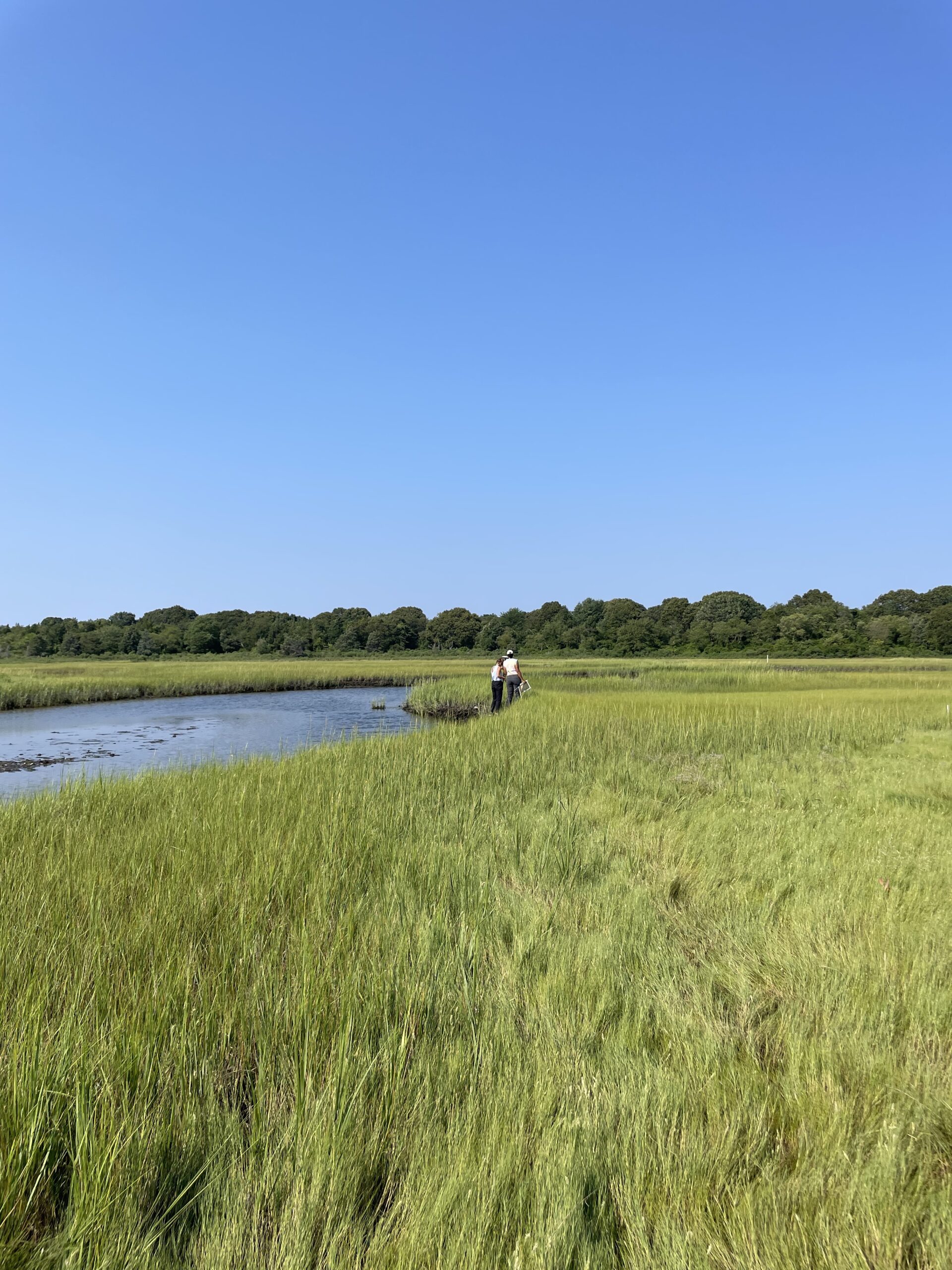
Credit: Katie Sperry, CC BY-SA 4.0.
An hour later I’m driving home from the lab, the sun setting orange over the ocean to my left. I’ve made this drive hundreds of times, but this is the first time doing so with my head full of thoughts about fungi. The idea of partnerships keeps floating back to me, and I feel a growing excitement about the promise of mutualisms; the fungal-plant collaborations Kylea and Mya are seeking and the collaboration they’re culturing between themselves.
Science can be a lonely endeavor, and while we can of course do great things on our own, there’s a special magic in working with someone else. As another lab mate of mine recently said, “talking about science with others is always more interesting and effective than thinking about it on my own.” As Kylea and Mya demonstrate, the alchemy of collaboration is extra potent when those involved are truly invested, not only in a project, but in each other.










